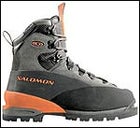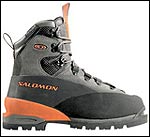It’s not uncommon for anyone, although I believe women suffer more from this problem because most plastics are built on men’s lasts, and women’s feet are shaped sufficiently differently for that to be an issue. And there’s not a good “fix” for it because trying to add padding to the tongue area of the boot—with foam, for instance—simply exacerbates things.
 SM Expert
SM Expert
All I can say is: Try several. I’ve used Koflachs and am neutral on the subject of their fit—neither bad nor great. I’m more favorably disposed toward the Scarpa Inverno ($290; www.scarpa-us.com), an extremely good buy in a high-end plastic boot. Weight per pair is around six pounds. The fit is generally excellent, with sufficient flex to help keep shin bruising to a minimum. For me, at least. I can’t say that’s going to be the case for you, so try a pair on in a store and walk around for a while before buying, then wear them at home for an evening before heading out on a climb.
You don’t say what you’ll be using these for, so I have to ask: Are you sure you need plastics? Because these days there are a whole bunch of leather or mostly leather boots that work extremely well in the cold/wet conditions in which plastics excel, but offer greater comfort. Scarpa’s Freney Pro ($279) is an excellent boot—fairly light and comfortable, yet capable of hard crampon work in cold conditions. So is Salomon’s SM Expert ($250; www.salomonsports.com), which incidentally is available in women’s sizing. I wore this boot—at just under five pounds per pair—up Mount Rainier last summer and was extremely impressed with it. So, unless you want a boot for winter mountaineering or expedition use, give leather a chance.
More boots and hikers reviewed in ���ϳԹ���‘s .


